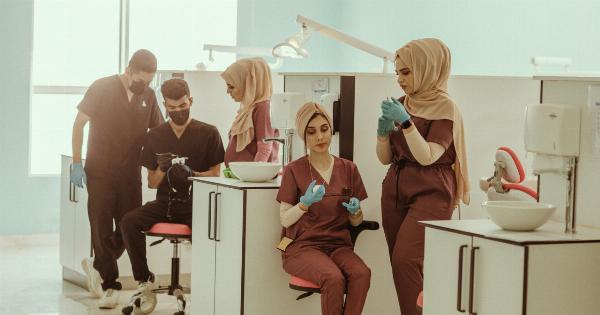Hospitals are places where sick and infected individuals go to get better. However, hospitals themselves can be breeding grounds for germs and bacteria that can cause patients and medical staff to become sick.
This is why proper sanitation and infection control practices are essential in every healthcare facility. Knowing where germs hide in a hospital can help prevent the spread of harmful microorganisms and ensure a safe and healthy environment for everyone.
1. Patient rooms
One of the most obvious places where germs can hide in a hospital is in patient rooms. These spaces are where patients spend most of their time, and it’s also where healthcare workers tend to spend the majority of their time caring for patients.
Common areas where germs can be found in patient rooms include:.
- The bed linens, which can become contaminated with bodily fluids and pathogens that can remain on the bed even after the sheets have been changed.
- Bathroom fixtures, such as sink faucets, toilet handles, and soap dispensers, which are frequently touched and can harbor germs from multiple people.
- The patient’s own body, which can harbor bacteria or viruses that can be transmitted to others.
2. Waiting rooms
Waiting rooms can also be hotspots for germs in a hospital. Patients and their families often spend prolonged periods in these spaces, and they can be exposed to germs through contact with contaminated surfaces or through airborne transmission.
Common areas of risk in a hospital waiting room include:.
- Chairs, which are frequently touched and can harbor bacteria or viruses from multiple people.
- Tables and reading materials, which can also be contaminated by patients or visitors.
- The air, which can contain infectious droplets from coughing or sneezing patients or visitors.
3. Medical equipment
Medical equipment is another area where germs can hide in a hospital. This includes items such as:.
- Stethoscopes and blood pressure cuffs, which are frequently used but often not cleaned thoroughly between patients.
- Surgical instruments, which can become contaminated if they are not sterilized properly.
- Infusion pumps and other electronic devices, which can harbor bacteria that can spread to patients through direct contact.
4. High-touch surfaces
High-touch surfaces are areas that are frequently touched by multiple people throughout the day. In a hospital, these surfaces can include:.
- Doorknobs and handles, which are touched by almost every person who enters or exits a room.
- Light switches, which are frequently touched but often overlooked when it comes to cleaning and disinfection.
- Elevator buttons, which can be contaminated by patients or visitors who have not washed their hands recently.
5. Staff areas
Hospital staff areas can also be areas where germs hide. Medical personnel move between potentially contaminated patient areas and sterile areas such as operating rooms. Common areas of risk for staff include:.
- Break rooms, where staff members eat and congregate during their downtime.
- Locker rooms, where healthcare workers change into scrubs or other protective clothing.
- Office spaces, where staff members may spend time working on administrative tasks or paperwork.
6. Food service areas
In a hospital, food service areas can also be a breeding ground for germs. These areas include:.
- The kitchen and food preparation areas, where cross-contamination can occur if proper food handling and sanitation practices are not followed.
- Dining areas, where patients and staff members may come into contact with contaminated surfaces and utensils.
7. Bathrooms
Bathrooms in a hospital can be a source of germs, as they are high-traffic areas that are frequented by patients, visitors, and medical staff. Common areas of risk in hospital bathrooms include:.
- Toilet seats, which can harbor bacteria and viruses from fecal matter.
- Sinks and faucets, which can become contaminated with bacteria from dirty hands.
- Soap dispensers, which can be contaminated if they are not cleaned regularly.
8. Laundry rooms
In a hospital, laundry rooms can also be a source of germs and bacteria.
Bed linens, towels, gowns, and other items that come into contact with patients’ bodies or bodily fluids need to be cleaned and disinfected properly to prevent the spread of infection. Common areas of risk in hospital laundry rooms include:.
- Washing machines and dryers, which can harbor bacteria if they are not cleaned thoroughly between loads.
- Contaminated laundry hampers, which can spread germs from one area of the hospital to another.
9. Hallways and elevators
Hospital hallways and elevators can be heavily trafficked areas that are frequently touched by many people. These spaces can be especially risky during flu season or other outbreaks of respiratory illness.
Common areas of risk in hospital hallways and elevators include:.
- Handrails, which are frequently touched but often not cleaned properly.
- Flooring, which can become contaminated with germs from coughs and sneezes.
10. Air vents and ductwork
Finally, air vents and ductwork in a hospital can also be a source of germs. The HVAC system is responsible for circulating air throughout the building, and if the system is not properly maintained, it can harbor bacteria and viruses.
Common areas of risk in hospital HVAC systems include:.
- Air vents, which can become contaminated with germs from the surrounding air.
- Ductwork, which can become contaminated with bacteria and viruses if they are not cleaned and disinfected regularly.
Conclusion
Germ and infection control is an essential part of healthcare facility management. Knowing where germs can hide in a hospital can help healthcare workers identify potential areas of risk and take appropriate steps to prevent the spread of infection.
Proper sanitation and disinfection practices, along with regular cleaning and maintenance, are critical in reducing the risk of infection and making hospitals safer environments for patients and staff alike.































